AMAZON multi-meters discounts AMAZON oscilloscope discounts
Electrostatic discharge (ESD) is the sudden and momentary electric current that flows between two objects at different electrical potentials. The term is usually used in the electronics and other industries to describe momentary unwanted currents that may cause damage to electronic equipment.
ESD is a serious issue in solid state electronics, such as integrated circuits. Integrated circuits are made from semiconductor materials such as silicon and insulating materials such as silicon dioxide. Either of these materials can suffer permanent damage when subjected to high voltages; as a result, there are now a number of antistatic devices that help prevent static build up.
Causes of ESD
One of the causes of ESD events is static electricity. Static electricity is often generated through tribocharging, the separation of electric charges that occurs when two materials are brought into contact and then separated. Examples of tribocharging include walking on a rug, rubbing plastic comb against dry hair, ascending from a fabric car seat, or removing some types of plastic packaging. In all these cases, the friction between two materials results in tribocharging, thus creating a difference of electrical potential that can lead to an ESD event.
Another cause of ESD damage is through electrostatic induction. This occurs when an electrically charged object is placed near a conductive object isolated from ground. The presence of the charged object creates an electrostatic field that causes electrical charges on the surface of the other object to redistribute. Even though the net electrostatic charge of the object has not changed, it now has regions of excess positive and negative charges.
An ESD event may occur when the object comes into contact with a conductive path. For example, charged regions on the surfaces of styrofoam cups or plastic bags can induce potential on nearby ESD sensitive components via electrostatic induction and an ESD event may occur if the component is touched with a metallic tool.
Types of ESD
The most spectacular form of ESD is the spark, which occurs when a strong electric field creates an ionized conductive channel in air. This can cause minor discomfort to people, severe damage to electronic equipment, and fires and explosions if the air contains combustible gases or particles.
However, many ESD events occur without a visible or audible spark. A person carrying a relatively small electric charge may not feel a discharge that is sufficient to damage sensitive electronic components. Some devices may be damaged by discharges as small as 10 V. These invisible forms of ESD can cause device outright failures, or less obvious forms of degradation that may affect the long term reliability and performance of electronic devices. The degradation in some devices may not become evident until well into their service life.
Sparks
A spark is triggered when the electric field strength exceeds approximately 4-30 kV/cm -- the dielectric field strength of air. This may cause a very rapid increase in the number of free electrons and ions in the air, temporarily causing the air to abruptly become an electrical conductor in a process called dielectric breakdown.

------- Lightning over an Eastern Europe city.
Perhaps the best known example of a natural spark is a lightning strike. In this case the potential difference between a cloud and ground, or between two clouds, is typically hundreds of millions of volts. The resulting current that flows through the ionized air causes an explosive release of energy. On a much smaller scale, sparks can form in air during electrostatic discharges from charged objects that are charged to as little as 380 V (Paschen's law).
Earth's atmosphere consists of 21% oxygen (O2) and 78% nitrogen (N2). During an electrostatic discharge, the intervening atmosphere become electrically overstressed. The diatomic oxygen molecules are split, and then recombine to form ozone (O3), which is unstable, or reacts with metals and organic matter. If the electrical stress is high enough, nitrogen oxides (NOx) can form. Both products are toxic to animals, and nitrogen oxides are essential for nitrogen fixation. Ozone attacks all organic matter by ozonolysis and is used in water purification.
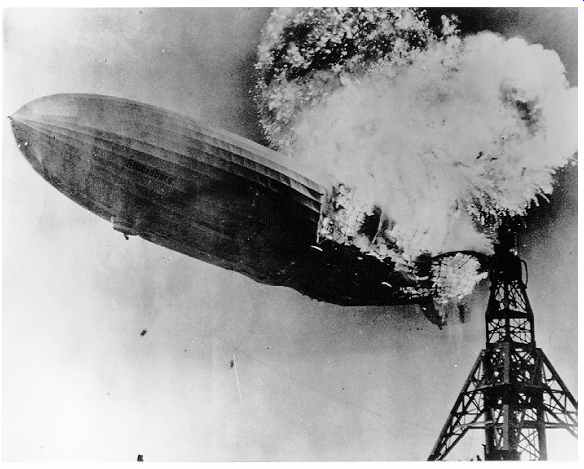
--- The Hindenburg, moments after catching fire.
Sparks can cause serious explosions because of the high temperatures reached in a spark.
Methane and coal dust explosions have been caused by electrostatic discharges. The Hindenburg disaster has been attributed to spark discharge igniting flammable panels tainted with thermite, which burned vigorously, violently, and extremely swiftly, which ultimately led to the ignition of hydrogen gas held in or leaking from the airship at the time. The ship had just passed through a thunderstorm and therefore may have acquired a large charge. Discharge supposedly occurred when mooring ropes were dropped as it came in to land in New Jersey in 1937.
Damage prevention in electronics
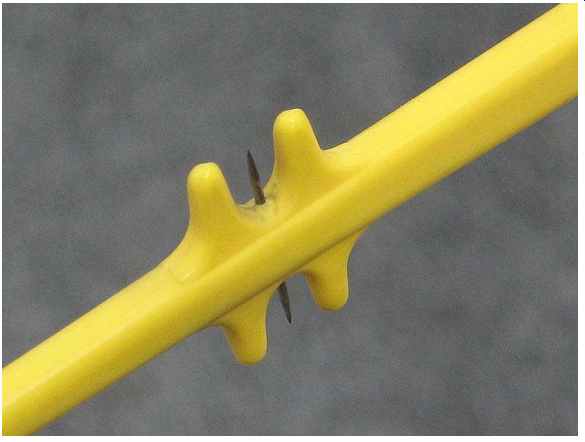
--- A portion of a static discharger on an aircraft. Note the two sharp
3/8" metal micropoints and the protective yellow plastic.
Prevention of ESD bases on Electrostatic Protective Area (EPA). EPA can be a small working station or a large manufacturing area. The main principle of an EPA is that there are no highly charging materials in the vicinity of ESD sensitive electronics, all conductive materials are grounded, workers are grounded, and charge build-up on ESD sensitive electronics is prevented. International standards are used to define typical EPA and can be found for example from International Electrotechnical Commission (IEC) or American National Standards Institute (ANSI). ESD prevention within an EPA may include using appropriate ESD-safe packing material, the use of conductive filaments on garments worn by assembly workers, conducting wrist straps and foot-straps to prevent high voltages from accumulating on workers' bodies, anti-static mats or conductive flooring materials to conduct harmful electric charges away from the work area, and humidity control. Humid conditions prevent electrostatic charge generation because the thin layer of moisture that accumulates on most surfaces serves to dissipate electric charges.
Ion generators are sometimes used to inject ions into the ambient airstream. Ionization systems help to neutralize charged surface regions on insulative or dielectric materials.
Insulating materials prone to triboelectric charging should be kept away from sensitive devices to prevent accidental charging of devices through induction. On aircraft, static dischargers are used on the trailing edges of wings and other surfaces.
Manufacturers and users of integrated circuits must take precautions to avoid ESD. ESD prevention can be part of the device itself and include special design techniques for device input and output pins. External protection components can also be used with circuit layout.
Due to dielectric nature of electronics component and assemblies, electrostatic charging can not be completely prevented during handling of devices. Most of ESD sensitive electronic assemblies and components are also so small that manufacturing and handling is made with automated equipment. ESD prevention activities are therefore important with those processes where component is touching on equipment surfaces. In addition, it is important to prevent ESD when electrostatic discharge sensitive component is connected with other conductive parts of the product itself. An efficient way to prevent ESD is to use materials that are not too conductive but will slowly conduct static charges away. These materials are called static dissipative and have resistivity values in the range of 10^5 to 10^11 ohm-meters. Materials in automated manufacturing which will touch on conductive areas of ESD sensitive electronic should be made of dissipative material, and the dissipative material must be grounded.
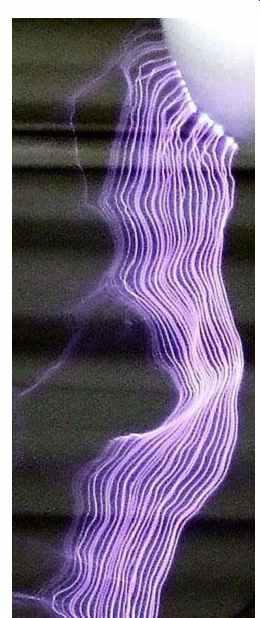
---- Electric discharge showing the ribbon-like plasma filaments from multiple
discharges from a Tesla coil.
Simulation and testing for electronic devices
For testing the susceptibility of electronic devices to ESD from human contact, an ESD Simulator with a special output circuit, called the human body model (HBM) is often used. This consists of a capacitor in series with a resistor. The capacitor is charged to a specified high voltage from an external source, and then suddenly discharged through the resistor into an electrical terminal of the device under test. One of the most widely used models is defined in the JEDEC 22-A114-B standard, which specifies a 100 picofarad capacitor and a 1500 ohm resistor. Other similar standards are MIL-STD-883 Method 3015, and the ESD Association's ESD STM5.1. For comportment to European Union standards for Information Technology Equipment, the IEC-61000-4-2 test specification is used. Guidelines and requirements are given for test cell geometries, generator specifications, test levels, discharge rate and waveform, types and points of discharge on the "victim" product, and functional criteria for gauging product survivability.
A Charged Device Model (CDM) test is used to define the ESD a device can withstand when the device itself has an electrostatic charge and discharges due to metal contact.
This discharge type is the most common type of ESD in electronic devices and causes most of the ESD damages in their manufacturing. CDM discharge depends mainly on parasitic parameters of the discharge and is strongly depending on size and type of component package. One of the most widely used CDM simulation test models is defined by the JEDEC.
Other standardized ESD test circuits include the following:
• Machine model (MM)
• Transmission line pulse (TLP)
Overvoltage
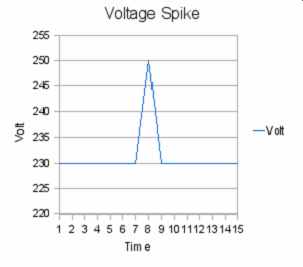
----- Voltage spike.
When the voltage in a circuit or part of it is raised above its upper design limit, this is known as overvoltage. The conditions may be hazardous. Depending on its duration, the overvoltage event can be transient-a voltage spike-or permanent, leading to a power surge.
Explanation
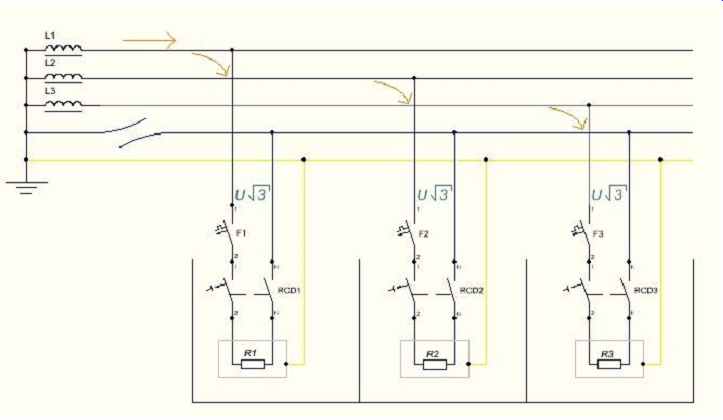
----- Lack of 3-phase electric system connected by star. If zero breaks
off, small-power appliances will be destroyed by overvoltage.
Electronic and electrical devices are designed to operate at a certain maximum supply voltage, and considerable damage can be caused by voltage that is higher than that for which the devices are rated.
For example an electric light bulb has a wire in it that at the given rated voltage will carry a current just large enough for the wire to get very hot (giving off light and heat), but not hot enough for it to melt. The amount of current in a circuit depends on the voltage supplied: if the voltage is too high, then the wire may melt and the light bulb would have "burned out". Similarly other electrical devices may stop working, or may even burst into flames if an overvoltage is delivered to the circuit of which these devices are part.
Sources
Natural
A typical natural source of transient overvoltage events is lightning. Bursts of solar wind following solar flares are also known to cause overvoltage in electrical circuits, especially onboard space satellites.
Man made
Man-made sources of spikes are usually caused by electromagnetic induction when switching on or off inductive loads (such as electric motors or electromagnets), or by switching heavy resistive AC loads when zero-crossing circuitry is not used - anywhere a large change of current takes place. One of the purposes of electromagnetic compatibility compliance is to eliminate such sources.
An important potential source of dangerous overvoltage is electronic warfare. There is intensive military research in this field, whose goal is to produce various transient electromagnetic devices designed to generate electromagnetic pulses that will disable an enemy's electronic equipment. A recent military development is that of the exploding capacitor designed to radiate a high voltage electromagnetic pulse. Another intense source of an electromagnetic pulse is a nuclear explosion.
Conduction path
The transient pulses can get into the equipment either by power or data lines, or directly through space from a strong electromagnetic field change -- an electromagnetic pulse (EMP). Filters are used to prevent spikes entering or leaving the equipment through wires, and the devices coupled electromagnetically to space (such as radio-frequency pick-up coils in MRI scanners) are protected by shielding.
Overvoltage protection devices
• Arcing horns
• Zener diode
• Avalanche diode
• Transil
• Trisil
• Spark gap
• Gas filled tube
• Metal Oxide Varistor
Overcurrent
In electricity supply, overcurrent or excess current is a situation where a larger than intended electric current exists through a conductor, leading to excessive generation of heat, and the risk of fire or damage to equipment. Possible causes for overcurrent include short circuits, excessive load, and incorrect design. Fuses, circuit breakers, temperature sensors and current limiters are commonly used protection mechanisms to control the risks of overcurrent.